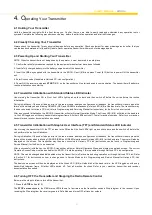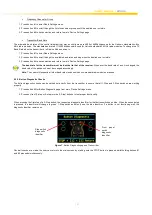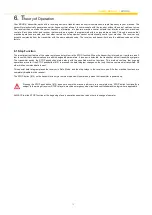
USE
R’S MANUAL |
ERGO-S
16
6. T
heory of Operation
Your ERGO-S transmitter works with a receiving device to transfer machine control commands via radio frequency to your machine. The
transmitter electronically generates a carrier frequency that allows it to communicate with the receiver without the use of cables or wires.
The receiver then converts the carrier frequency information into discrete machine control outputs
that interface with your machine’s
controls. Each transmitter and receiver that comprises a system is programmed with a unique address code. This code ensures that
machine operations are safe, and that other remote control equipment cannot unintentionally control your machine. The receiver only
accepts commands from the transmitter with the same address code. The receiver and transmitter have the address code set at t he
factory.
6.1 Stop Function
The most important feature of the radio remote control system is the STOP function. When the transmitter is turned on, it performs a self-
test to confirm that communications are within designated parameters. If an error is detected, the transmitter will not transmit any signals.
The transmitter sends the STOP pushbutton status along with the specified machine functions. This method confirms that ongoing
operations are safe. If the STOP pushbutton (#15) is pressed, the data telegram changes so that only the stop command is transmitted. No
other motion command data is sent.
This special data telegram places the receiver in Safe Mode, and the stop relays in the receiver open. All other machine functions are
completely disabled in the receiver.
The STOP button (#15) on the transmitter is only a remote stop and will operate only when the transmitter is powered up.
Pressing the STOP pushbutton (#15) does not ensure the machine will come to a complete stop. STOP button functionality is
subject to the wiring of receiver STOP relays to machine emergency stop circuit and controlled machine logic where applicable.
ALWAYS test the STOP function at the beginning of every operation session or when there is change of operator.














































